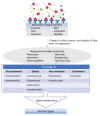Triple Negative Breast Cancer: A Review of Present and Future Diagnostic Modalities
- PMID: 33445543
- PMCID: PMC7826673
- DOI: 10.3390/medicina57010062
Triple Negative Breast Cancer: A Review of Present and Future Diagnostic Modalities
Abstract
Triple-negative breast cancer (TNBC) is an aggressive breast type of cancer with no expression of estrogen receptor (ER), progesterone receptor (PR), and human epidermal growth factor receptor-2 (HER2). It is a highly metastasized, heterogeneous disease that accounts for 10-15% of total breast cancer cases with a poor prognosis and high relapse rate within five years after treatment compared to non-TNBC cases. The diagnostic and subtyping of TNBC tumors are essential to determine the treatment alternatives and establish personalized, targeted medications for every TNBC individual. Currently, TNBC is diagnosed via a two-step procedure of imaging and immunohistochemistry (IHC), which are operator-dependent and potentially time-consuming. Therefore, there is a crucial need for the development of rapid and advanced technologies to enhance the diagnostic efficiency of TNBC. This review discusses the overview of breast cancer with emphasis on TNBC subtypes and the current diagnostic approaches of TNBC along with its challenges. Most importantly, we have presented several promising strategies that can be utilized as future TNBC diagnostic modalities and simultaneously enhance the efficacy of TNBC diagnostic.
Keywords: breast cancer; future diagnosis; triple negative breast cancer.
Conflict of interest statement
The authors declare no conflict of interest.
Figures




References
-
- Vallejos C.S., Gómez H.L., Cruz W.R., Pinto J.A., Dyer R.R., Velarde R., Suazo J.F., Neciosup S.P., León M., de la Cruz M.A., et al. Breast Cancer Classification According to Immunohistochemistry Markers: Subtypes and Association With Clinicopathologic Variables in a Peruvian Hospital Database. Clin. Breast Cancer. 2010;10:294–300. doi: 10.3816/CBC.2010.n.038. - DOI - PubMed
-
- Nielsen T.O., Hsu F.D., Jensen K., Cheang M., Karaca G., Hu Z., Hernandez-Boussard T., Livasy C., Cowan D., Dressler L., et al. Immunohistochemical and Clinical Characterization of the Basal-Like Subtype of Invasive Breast Carcinoma. Clin. Cancer Res. 2004;10:5367. doi: 10.1158/1078-0432.CCR-04-0220. - DOI - PubMed
-
- Sørlie T., Perou C.M., Tibshirani R., Aas T., Geisler S., Johnsen H., Hastie T., Eisen M.B., van de Rijn M., Jeffrey S.S., et al. Gene expression patterns of breast carcinomas distinguish tumor subclasses with clinical implications. Proc. Natl. Acad. Sci. USA. 2001;98:10869–10874. doi: 10.1073/pnas.191367098. - DOI - PMC - PubMed
Publication types
MeSH terms
Substances
Grants and funding
LinkOut - more resources
Full Text Sources
Other Literature Sources
Research Materials
Miscellaneous

